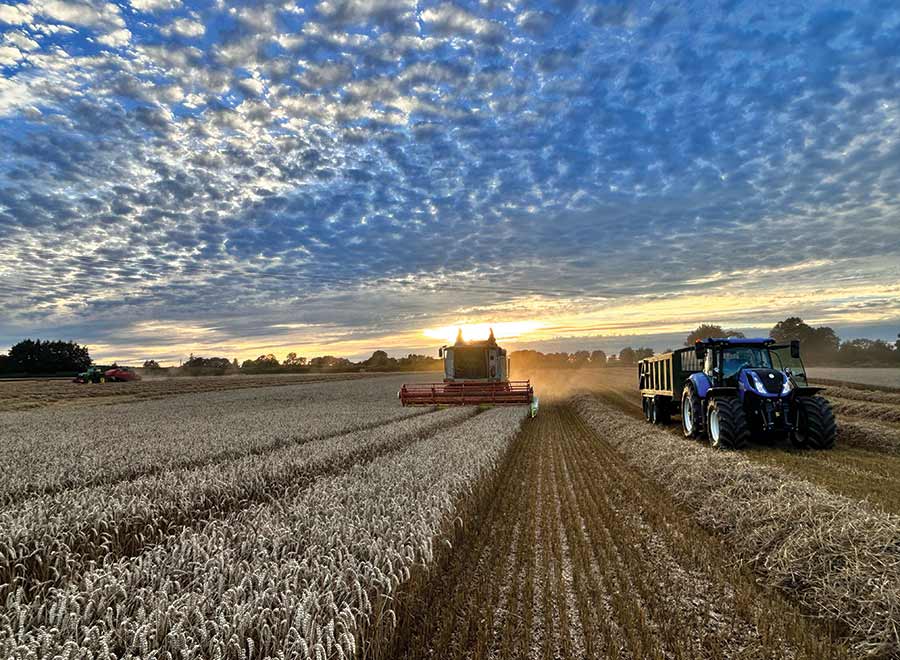Harvest 2023: Quality woes with milling wheat downgrades

Combining Crusoe winter wheat under spectacular skies at High Chimney Farms near Canterbury © Molly McCabe
Nitrogen levels in malting barley are pleasingly low, with most samples making full-spec grades despite not looking pretty.
But while milling wheat Hagberg numbers are mostly intact in the South, they are falling elsewhere, and protein contents are on the low side.
See also: Harvest 2023: Early spring malting barley crops show promising quality
Lincolnshire
Farmers supplying Woldgrain are about halfway through harvest, with 38,000t in store so far.
Spring barley has good germination and screenings and generally low nitrogen; so far more than 4,000t of Planet is averaging 1.54% nitrogen.
Woldgrain operations manager Dan Murphy says: “In a normal year we would expect it to be higher than that, to the point where some would be downgraded to feed; at the moment it’s all full-spec malting.”
It has also averaged 64.7kg/hl specific weight, while another 1,600t of Laureate is averaging 1.51% nitrogen and 64kg/hl.
It is a different story for milling wheat, as out of 3,000t of Skyfall, only 1,000t has made milling specification, with 750t at low milling quality and the rest downgraded to feed.
The average quality for Skyfall – albeit within a wide range – is 207 Hagberg, 12% protein, and 76.5kg/hl.
There is also 1,700t of Crusoe winter wheat in store. “Only 700t has made full-spec milling, the rest is split evenly between feed and low-grade milling,” says Dan.
The average Hagberg is 250, with protein averaging 12.2% and specific weight 75.4kg/hl.
Winter oats have also been nothing special, with the 400t seen so far averaging 52kg/hl. Oilseed rape harvest is now complete in the area, with 6,300t in store, levelling at 43.9% oil content.
Hertfordshire
At Harlow Ag Merchants near Bishop’s Stortford, milling wheat harvest should be finished by the end of this week, but has been disappointing compared with last year.
In terms of quality, specific weights are 72-77kg/hl, which is 3-5kg/hl down. Protein contents are marginally better than last year (which in itself was a low-protein year), with Extase at about 11-11.5%.
Winter wheat Hagbergs are generally above 225 seconds, says grain director Stuart Attridge.
He adds that spring beans and peas have had disastrous yields, and spring wheat looks weathered, but spring barley is an exception with good nitrogen levels at 1.4-1.5%.
Flea beetle and stem weevil were a major headache in oilseed rape, with resulting yields around 2.5t/ha and very small seed due to the dry weather before harvest.
“Some crops in the North have better yields, averaging 2.97t/ha to 3.46t/ha,” he says. Oil contents are down 1-2 percentage points compared with last year.
Sussex
Farmers supplying Bartholomews Agri Food are 80% through harvest. “Given the weather and fears we had, we are pleasantly surprised by where we’re ending up,” says grain manager Richard Wright.
For malting barley, Laureate is outperforming Planet, reversing the trend seen last year.
Milling wheat has been good quality so far, but Richard predicts that wheat cut in the next two weeks will have lost its Hagberg.
“If you compare longer-term yields, I think everything’s done quite well, and a few people have actually beaten the five-year average,” he says.
But dryers have been on 20 hours a day, after not being used at all last year.
Somerset
Yields further west have also been in line with five-year average, according to Cefetra Wessex. It has received 8,000t of mainly Laureate and Planet malting barley and 4,000t of milling wheat.
Malting barley quality has been super, with germination averaging 98%, good retentions, and nitrogen content on the low side at 1.58%.
In contrast, milling wheat has been disappointing, as only 1,000t has made full-spec. Extase has averaged 11.5-12.5% protein, with a good Hagberg at 300-plus.
Farm grain origination manager Simon Wilcox says: “Milling wheat quality has been variable; farmers should get wheat tested and segregated where they can, as millers may take crops at a lower level than normal. Keep anything down to 11.4% protein separate.”

